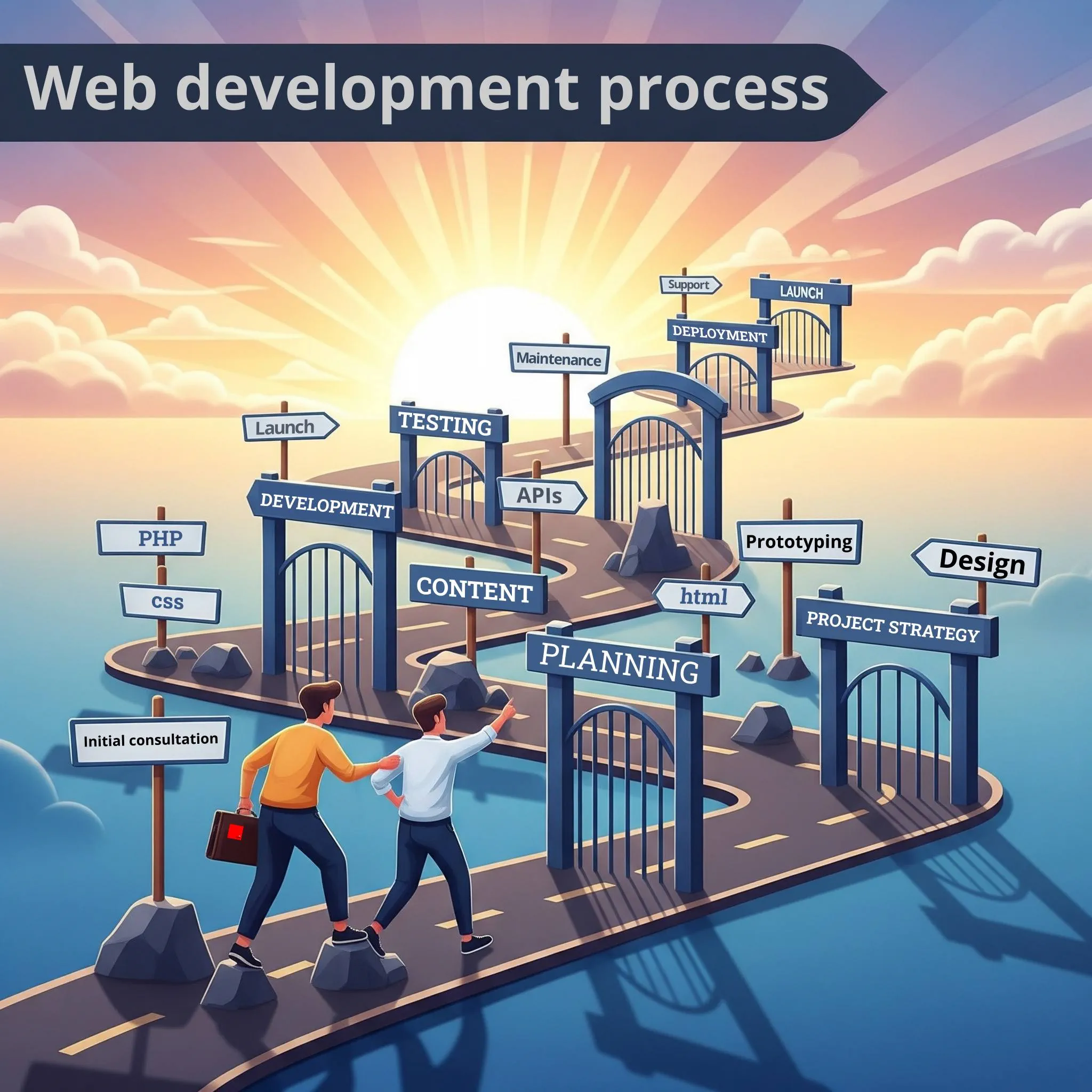-
1.
A client’s guide to agile web development project process
-
1.1.
The agile advantage: A dynamic project process
- 1.1.1. Waterfall projects: a contrast for the agile project process
- 1.1.2. The agile project process: A flexible, iterative approach
- 1.1.3. 1. Discovery & inception: Setting the foundations of the agile project process
- 1.1.4. 2. Sprint planning: Defining each next small step in the agile project process
- 1.1.5. 3. Development sprints: building, iterating, and showing progress
- 1.1.6. 4. Daily stand-ups (optional for clients, but transparent)
- 1.1.7. 5. Sprint retrospective: Learning and improving throughout the project process
- 1.1.8. 6. User Acceptance Testing (UAT): Your final seal of approval
- 1.2. Building bridges, not barriers to project success: The partnership imperative
- 1.3. Conclusion: Your digital success story
- 1.4. Further reading
-
1.1.
The agile advantage: A dynamic project process
A client’s guide to agile web development project process
Embarking on a website project can feel daunting. You have a vision, and you need a digital partner to bring it to life. However, concerns about costs, timelines, and the ultimate outcome can sometimes cloud the excitement. Sometimes these concerns, coupled with a fear of the unknown, can get in the way of even starting your project. This article aims to demystify the whole digital project process. Specifically it focuses on agile project management for digital projects. It highlights how to deliver a successful project through a collaborative partnership between client and web developer. Forget the mistrust and misguided ideas; embrace a journey of mutual trust and a shared focus on your end goal.
The agile advantage: A dynamic project process
Waterfall projects: a contrast for the agile project process
To truly appreciate the benefits of agile, it’s helpful to understand what it contrasts with. Traditionally, many projects, especially in web development, followed a “waterfall” or rigid approach. This often meant extensive upfront planning to meticulously define every single detail of the website any development work even began. Think of it like drawing a complete, unchangeable blueprint for a house before laying a single brick. Development proceeds in strict, sequential phases following “sign off” of the blueprint. The phases include requirements gathering, design, development, testing, and finally, launch. The client’s only involvement occurred at the very beginning and then again at the very end, leaving little room for adaptation or feedback in between.
In many cases, the fear and distrust of project processes traces back to the use of such a rigid approach to project planning. With limited involvement, the project could easily and quickly run away from the client, without any control. And the end result rarely gave the client much satisfaction, or users much value.
The agile project process: A flexible, iterative approach
In stark contrast, agile project management embraces flexibility, iterative development, and continuous improvement. For a website project, this means your site evolves through a series of short, focused cycles rather than a single, monolithic build. This dynamic project process is particularly effective for creative project management, allowing for adaptation and innovation as the project progresses.
Instead of a fixed blueprint, agile is more like charting a course, with regular check-ins and opportunities to adjust sails based on changing conditions or new discoveries. This approach uses responsiveness and efficiency to meet the evolving nature of digital requirements. And it means the client can play a central role throughout the project process, making decisions and updating requirements as necessary. This means the client will achieve a far better result, adapted to their needs.
The methodology used for an agile project is remarkably different to a traditional project. Gone are the clipboards and Gantt charts, replaced by post-it notes and stand-up meetings. But the most important difference is the involvement of the client throughout the project process. Below is a breakdown of how a typical agile project might run:
1. Discovery & inception: Setting the foundations of the agile project process
This initial phase involves deep dives into your business, your target audience, your goals for the website, and your brand identity. It’s about understanding the “why” behind your project. Rather than defining every single feature upfront, we focus on understanding the core problem the website needs to solve and the key functions it must deliver.
Client involvement: Client input is most critical in this stage. Therefore, expect intensive workshops and discussions. You will need to share your vision, provide existing brand assets, identify your competitors, and outline your desired user journeys. Your active participation here ensures a clear understanding of your needs. This isn’t about signing off on a rigid specification; in contrast, it’s about collaboratively defining the project’s direction and priorities. This sets the framework for the whole project, it’s really essential to be open and collaborative.
To prepare for this stage, consider using our project planning tool, The Website Development Workbook. It is a free 28-page resource that helps to identify requirements for a website development project.
2. Sprint planning: Defining each next small step in the agile project process
Agile projects are broken down into “sprints,” typically lasting 1—4 weeks. You will work collaboratively with the development team at the beginning of each sprint to decide which features to build in that specific project timeframe. These are known as “user stories.”
Client involvement: You’ll be an active participant in sprint planning meetings. This is your opportunity to prioritise features based on business value and urgency. Through your inclusion in the project team, you’ll gain an understanding of why the team develops certain elements before others. That way, you’ll see what’s on the immediate horizon and which features are further down the track. This transparency empowers you to influence the development roadmap in real-time.
3. Development sprints: building, iterating, and showing progress
During a sprint, the development team focuses on building the agreed-upon user stories. This includes design, coding, content integration, and initial testing. The beauty of agile is that work is typically “shippable” by the end of a sprint, meaning a functional (though not always complete) piece of the website is ready for review.
Client involvement: This is where trust and engagement become paramount. You are not passively watching at this stage. You will attend sprint reviews, or demos, at the end of each sprint. These will show you what the developers built during the sprint. This isn’t just a status update; it’s an opportunity for you to:
- Provide feedback: See the work in progress and offer immediate thoughts, suggestions, and corrections;
- Ask questions: Clarify any aspects of the development that you don’t understand; and,
- Make adjustments: If something isn’t quite right or a new opportunity arises, agile allows for course correction early on, saving time and cost in the long run.
This constant feedback loop ensures the project remains aligned with your evolving vision and prevents costly misunderstandings from snowballing. But it’s also important to remember that at this stage you will not see a finished product. You will see a working just-built function that will fit in to a bigger system.
4. Daily stand-ups (optional for clients, but transparent)
The development team typically holds short daily meetings (stand-ups) to discuss progress, obstacles, and plans for the day.
Client involvement: The project manager will summarise key takeaways from the stand-ups for you; in general the team won’t ask you to attend. This provides an ongoing sense of progress and allows for quick resolution of any roadblocks that might from time to time need your input.
5. Sprint retrospective: Learning and improving throughout the project process
The development team and the client reflect on the sprint to determine what worked, what needs improvement, and what priority changes to consider for future sprints. This fosters continuous improvement in the project process.
Client involvement: Your insights are invaluable here. Did communication work well? Were your expectations met? Your feedback directly contributes to refining the working relationship and optimising the development flow. Thus, ensuring how to deliver a successful project becomes more efficient with each iteration.
6. User Acceptance Testing (UAT): Your final seal of approval
As the project nears completion, and throughout various stages, you’ll have dedicated periods for User Acceptance Testing (UAT). This is your opportunity to thoroughly test the website from a user’s perspective, especially to ensure it meets all your functional and aesthetic requirements. This can also be a great opportunity to invest in some user research [user research guide: creating websites users love].
Client involvement: This is your final comprehensive review. You’ll systematically go through the website, identify any bugs or inconsistencies, and confirm that all features work as expected. Your detailed feedback here is crucial for ensuring the final product meets your high standards before launch. It should be built on previous reviews of sprints, where your feedback has been considered and incorporated into the work.
Building bridges, not barriers to project success: The partnership imperative
The success of your website project hinges on a strong, collaborative partnership between you and your web development team. Agile isn’t just a methodology; it’s a mindset that champions transparency, communication, and mutual respect.
Dispelling concerns and eliminating surprises
One of the most common anxieties for clients embarking on a digital project is the fear of the unknown. With traditional, rigid project approaches, there’s often a “big reveal” at the very end, where the client sees the completed product for the first time. This can be a nerve-wracking experience, fraught with the potential for misaligned expectations or costly last-minute changes.
Agile fundamentally changes this project process. By involving you in frequent sprint reviews and demos, you see tangible progress every few weeks. This continuous visibility of the product, as it’s developing, gives you opportunities to provide feedback, influence direction, and refine the product. There are no sudden surprises, dramatically reducing the risk of a final deliverable that doesn’t quite match your vision, thus alleviating common concerns from the outset.
Often the development team can incorporate changes of scope and direction flexibly into the project process at no additional cost. This is because earlier feedback enables the project to quickly change priorities for the sake of the project’s success. This is because most of the work hasn’t already been done when you provide feedback, so the project can change priorities. Occasionally, a revision might need extensive changes to completed work. In this case, the project team will discuss with you the project impacts of the change and any additional costs it involves before agreeing the way forward.
Fostering trust and transparency
The iterative and transparent nature of agile actively fosters trust. When you’re regularly seeing working software, participating in planning, and contributing to retrospectives, you gain a deep understanding of the development team’s dedication, expertise, and the challenges they might encounter.
This direct exposure builds confidence in the entire project process and in the people delivering your project. An open dialogue breaks down the “us vs. them” mentality that can sometimes emerge in traditional client–vendor relationships, replacing it with a genuine sense of shared purpose and collaboration. You experience the direct impact of your feedback, which reinforces the belief in the value of your input and your integral role in project success.
In an agile environment, both client and developer are deeply invested in the project’s success. The iterative planning, the prioritisation of features based on business value, ensures that every effort directly contributes to the ultimate objective.
Agile encourages a shared understanding of what constitutes a successful outcome, moving beyond a simple list of features to a deeper comprehension of the value the website will bring to your business. This mutual commitment ensures that every decision and every sprint contributes efficiently and effectively to achieving that goal.
This collaborative project process means both parties are pulling in the same direction, united by a common aim: to deliver a truly impactful digital solution.
Conclusion: Your digital success story
Choosing an agile approach for your website project in the UK means choosing a dynamic, collaborative, and transparent journey.
This dynamic project process empowers you, the client, to be an active participant every step of the way. Gone are the days of passively waiting for a final product that might or might not align with your evolving vision. Gone are the days of attending a final project gate and finding the built product is nothing like what you wanted. You need not live for fear that your project has run away without you into some monster lurking in the shadows.
With agile, you’re not just a client; you’re an integral part of the team, influencing priorities, providing real-time feedback, and witnessing the development unfold before your eyes.
Ultimately, this partnership, built on mutual trust and a shared vision, is the key to unlocking the full potential of a creative project. By embracing the flexibility and collaborative spirit of agile, you’re investing in a methodology that is purpose-built for the complexities and rapid evolution of digital projects.
It’s about more than just delivering a website; it’s about how to deliver a successful project that not only meets but genuinely exceeds your expectations, setting your digital presence up for long-term success.
Embrace the agile way, and let’s build something remarkable together
Further reading
Website development UK: A complete guide for business
Website development workbook (a free 20-page resource to download)





